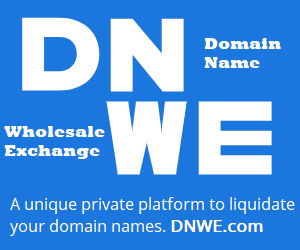After releasing part 4 of my “How I Make Money” series, people asked where Part 3 was. I forgot to post it. So here it is.
Every domain is unique. That is the true value of a domain. There is no exact matching domain in the world like the one you own. The price truly is whatever you want it to be. It’s yours. You name the price. But let’s pretend you actually want to sell it. Let’s get away from the dreams of someone offering you a million dollars for you name and move into the price you may actually get.
I’ve mention in the second post of this series that I like liquid domains. Domains that easily sell every day. There are two reasons I like these domains. One, I can always find a seller but another major reason I like them is measurable history. It is much easier to put a price on a domain when there is comparable sales history. While this doesn’t mean you have to sell the domain for the same prices as those before you, it is a good base to start. It gives you a bottom. A “why would I sell it for this price when domain X sold for that two months ago”. Again, no domain is exactly the same so the comparables are often stretched by the seller. I can’t tell you how many times I’ve received statements like lawyers.com sold for a million and I have DetroitAreaLawyers.com for only $5400 (made up prices). There is no comparison here. Lawyer.com and Lawyers.com yes. Those two no.
My research tool of choice is Namebio.com. It’s the original source of sales history on the net. It’s what Estibot was built on but it has grown and continued to add data under Adam Strong and company. I always look to see if the domain I’m interested in has ever been sold publicly or if a similar name has been sold as well. I’ll also do a Google check for the same reason. Namebio doesn’t have every sale but it has most of DnJournal’s and Sedo and some of Namejet’s as well. In short, it’s not perfect but I think its the best.
So now I have some similar sales from history. I will also look at potential. How many searches for this term are on Google and with those searches, what is the monetization possibilities, ie what’s the CPC? I think the CPC and searches are often overrated but it does give you potential and potential is the driver behind 95% of all purchases. Whether or not you can get any of that CPC money is determined by so many more variables. If you have a domain that pays $24 CPC but the competition is high and incredibly difficult to rank then realistically you will never see daylight in Google. To me that brings the value down. Value up because of potential, value down because of difficulty of monetization.
Let’s get back to liquid domain, domains that seem to always sell. CCC.com, LLLL.com, NNNN.com, LL.orgs. They are names that are sold closer to stocks. All close in value with some being a little better than the others. The main reason I like these is two reasons. They sell so well there is a lot of history. Second, there are limited amounts. NNNN.coms for instance, only have roughly only 10,000 domains. I have tracked the sale of over 1000 of them over the years. That means I have the sales data of 10% of all names available. You can’t say that about many types of domains. It gives me a pretty good idea what I can get for the name. It also lets me know what I should pay. It obviously needs to be under the “going rate” of that type. This has served me well during this recent upswing in pricing. Buy low, sell high. Sounds pretty simple. You just have to know what low is and you have to keep the sales price to a level that you can sell the domain quickly. Using Namebio’s history, and staying with the short domains, I have been able to do a pretty good job of doing both this last year


… “Second, there are limited amounts. NNNN.coms for instance, only have roughly only 10,000 domains” …. Critical info. Supply/Demand and unlike a stock these 10,000 domains (.com) can never be diluted away by issuing more shares.
… “I have tracked the sale of over 1000 of them over the years. That means I have the sales data of 10% of all names available.”
Doing your homework has paid off.
Thanks for sharing.
How did you know there are only 10,000 NNNN.com’s available? Basic Math or is there a site that says that?
@John
0000 to 9999 = 10,000 available NNNN’s as this would cover all the numeric possiblities.
Thing is, domainers regularly undersell good domains to hold onto their crap domains, we do it too, it’s human nature.
Shane, you have an offline business too, truly what is $10,000 in the whole scheme of things?
If you see how it benefits you, it’s an easy business expense to justify, isn’t it?
You still have those impulse buyers out there who overpay for domains. They fuel the overpricing by domain owners.
I took a look at Namebio and there are not many sales reported from Godaddy. I see a lot of 50k offers on Godaddy everyday though. Why is that?